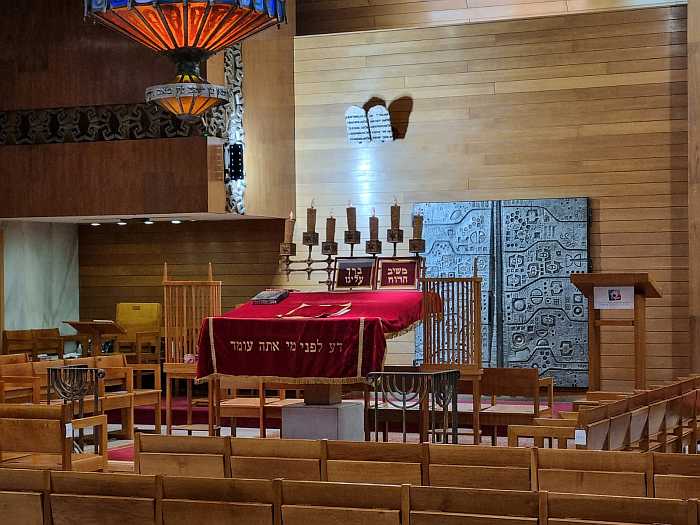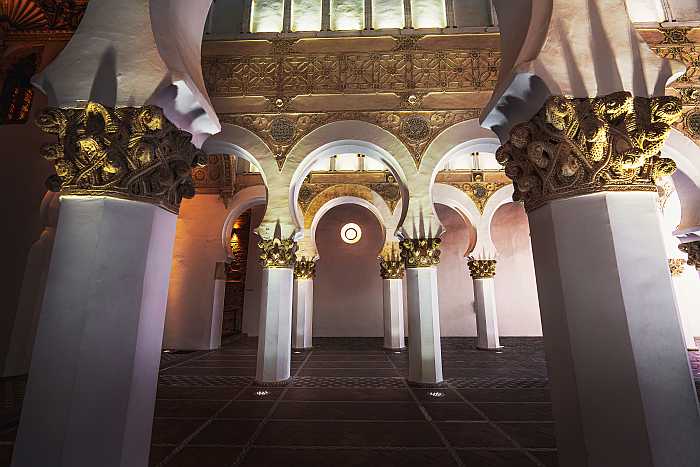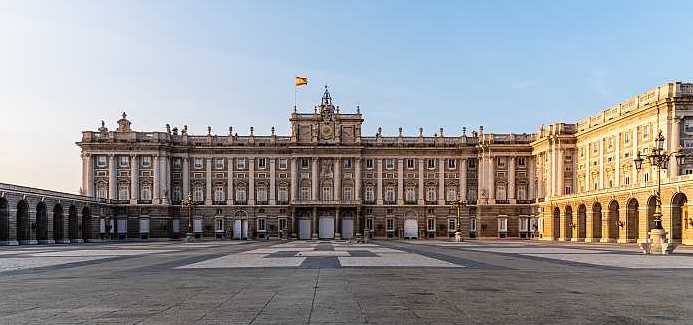
Beth Yaacov Synagogue in Madrid (Photo: Rabbi Zalman Goldstein)
Madrid, the capital of Spain, sits 2,120 meters above sea level, making it one of the highest capitals in Europe. The summer months in Madrid are hot and dry with little or no rain and temperatures sometimes climbing above 100 degrees. The winter months tend to be long and cold but spring and autumn are very pleasant.
Madrid has a long and sometimes tragic Jewish history, marred by the Spanish Inquisition and expulsion. It is an integral piece of the history of Sephardic Jews, who were expelled from the country in the 15th century. There is an active Jewish community and Chabad House and much to see and do in the city. Whether you're looking to explore the city's Jewish heritage or to discover more of the city and surrounding areas, a vacation in Madrid is sure to be filled with interesting sights and experiences. Find out more about current active Jewish and kosher facilities in Madrid.
Jewish History
There are traces of Jewish history in Spain dating as far back as the 9th century and by some accounts even to the 3rd century, however historical records date back only as far as 1053. Beginning in 1085, Jews were confined to “the juderia” ( old Juderia), near the present-day Teatro Real Opera house. After the Black Death outbreak, around 300 years later, the Jews were forced to move to the new juderia, near the Plaza de la Armeria. The new Jewish quarter had about twenty houses and a synagogue, scattered across six blocks.
The Jewish community saw growth and prosperity during the 13th and 14th centuries but growing antisemitism and violence saw the Jewish community dwindle. Many were killed in a massacre in 1391, forced to convert to Christianity or move outside the city walls. There is little physical evidence left of the ancient Jewish community of Madrid but historians were able to piece together details based on written texts.
After the Jews were expelled from Spain in 1492, there was no Jewish presence in the country for 400 years. Jews began to return to Madrid in the 1860’s.The Jews of Madrid commemorated the 90th anniversary of the first synagogue opened in the city after the Spanish Inquisition by establishing the History Museum of the Jewish Community of Madrid. The museum has pictures, documents and publications with information on Jews in Madrid and in Spain, including records of their return to the Iberian Peninsula 400 years after being expelled.

Interior of the Synagogue of Santa Maria la Blanca - Ibn Shoshan Synagogue in Toledo (Photo: Envato)
Modern Jewish community
There are around 15,000 Jews living in Madrid today - 5,000 officially, meaning affiliated with the community and an estimated 10,000 unofficially. The Jewish community in Madrid is around 100 years old, originating mainly from Morocco in the late 1940’s after the war. Many of the Spanish-speaking Moroccan Jews who left Morocco came to Madrid. More recently, there has been an influx of Jews coming from South America. The Beth Yaacov Synagogue, located in the Jewish Community Center has minyan every day and on Shabbat. There is an active and vibrant Jewish community in the city including the Jewish Community Center and the Chabad House.
Rabbi Zalman Goldstein has been the Chabad rabbi in Madrid for five years but he is no stranger to the city. This was a homecoming for Rabbi Zalman whose father, Rabbi Yitchok Goldstein is the Head Shaliach in Spain. He was sent by the Rebbe to Malaga, Spain in 1977 then he came to Madrid in 1979, where he still resides.
Rabbi Zalman grew up in the local Jewish community of Madrid. After learning in yeshiva and becoming a sofer, he lived in Israel for many years but said that he “always knew in the back of my head that eventually I would return to the city.” I was fortunate to be able to speak to Rabbi Zalman to gain some insight into the Jewish community and tourism to the city. Rabbi Zalman said that he has three constituents in the city that he deals with: the local community, Jewish exchange students and tourists, which is the largest group of the three.


Rabbi Zalman Goldstein with students at the Chabad Madrid (Photo: Rabbi Zalman Goldstein)
Rabbi Zalman is very familiar with the local community that he grew up in and he davens in the local shul during the week as Chabad only has minyan on Shabbat. Rabbi Zalman looks forward to working more closely with the local Jewish community in the future, including strengthening the local Jewish school and kosher possibilities in Madrid. There are around 1500 Jewish exchange students in Madrid every year. They come to Chabad for Shabbat services and meals. Chabad also provides activities and shiurim for them. In addition, there is a group called Olami whose focus is students and young professionals in Madrid, including Shabbat meals and activities and has a great collaboration with Chabad.
A big part of Chabad activities in Madrid are the Shabbat meals, which average about 100 people every Friday night. Most of the participants are tourists but there are also students who come weekly and hopefully, feel at home. Around 80% of the tourists are Israelis but he’s seeing more Americans in recent years as well as French and South Americans. Summer is the busy season but winter months are picking up too as many Israelis come for the soccer games - a game between Barcelona and Madrid could attract between four and five thousand Israelis.
Rabbi Zalman ended by saying: “I see the Chabad of Madrid developing more in the next couple of years. I look forward to bringing another couple or two to grow the Chabad of Madrid.”

Royal Palace Madrid (Photo: Envato)

Royal Palace Madrid (Photo: Envato)
Jewish sights, local landmarks & day trips
- English Cemetery: the Jews didn’t have their own cemetery so they carved out their own section in the English Cemetery
- Jewish Community Center/Synagogue Beth Yaacov of Madrid: The Visitor Center houses a permanent exhibit taking guests through the history of Jewish life in Madrid. Advanced reservations are required.
- Monument to the Victims of the Holocaust: located in the Juan Carlos I Park in Madrid, next to the Garden of the Three Cultures (symbol of the coexistence in Spain of the Hebrew, Christian and Muslim civilizations).
- Toledo: about 70 km from Madrid and home to one of the best-preserved Jewish neighborhoods in Spain.
- Jewish quarter of Segovia: about 90 km from Madrid, the city is built on a rock over 1000 meters high and has been declared a World Heritage Site. The city's Jewish Quarter is an example of its old-world charm.
- The Prado Museum: the main Spanish national art museum houses one of the world's finest collections of European art.
- Plaza Mayor: large public space in the heart of Madrid
- The Royal Palace of Madrid: official residence of the Spanish royal family which is not only used for state ceremonies. It is the largest royal palace in Europe.
- Santiago Bernabeu Stadium: The museum is modern with interactive screens and displays going through the history of Real Madrid. A must-see for soccer fans visiting the city.
Conclusion
Madrid is an amazing city with rich Jewish history as well as local art and culture. Get to know the local Jewish community of Madrid and explore the Jewish landmarks in nearby cities. There are a number of kosher restaurants to choose from when you get hungry. You can use TJT's Kosher Near Me tool when walking the streets of Madrid to help you find kosher restaurants. If you are spending Shabbat in the city, there are hotels near the Jewish community so you can go to the shul or Chabad House for minyan and meals. Visit the art museums, plazas and dive into the local culture. Take some time and experience all the unique opportunities this vibrant city has to offer – it will be an unforgettable journey!